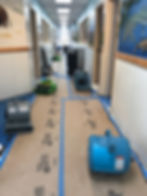Essential Drying Equipment for Water Damage Restoration: Air Movers Dehumidifiers and More
- Water Removal Pros
- Nov 6
- 3 min read
Water damage can cause serious problems in homes and businesses. When water invades walls, floors, and furniture, quick and effective drying is crucial to prevent mold growth, structural damage, and lingering odors. Using the right water damage equipment speeds up the drying process and ensures a thorough restoration.
This article explores the most common drying tools used in water damage restoration. Understanding how each piece of equipment works helps property owners and restoration professionals tackle water damage efficiently.

Air Movers
Air movers are powerful fans designed to circulate air rapidly across wet surfaces. They increase evaporation by moving dry air over damp materials like carpets, drywall, and wood.
Types: Axial and centrifugal air movers are common. Axial models move air in a straight line, while centrifugal ones push air at a 90-degree angle.
Use: Place air movers around the affected area to create airflow patterns that speed drying.
Benefits: They reduce drying time from days to hours, preventing secondary damage.
Air movers are often the first line of defense in water damage restoration, helping to dry surfaces before deeper moisture removal begins.
Dehumidifiers
Dehumidifiers remove moisture from the air, lowering humidity levels inside the affected space. This step is critical because high humidity slows drying and encourages mold growth.
Types: Refrigerant dehumidifiers work best in warm environments, while desiccant dehumidifiers perform well in cooler conditions.
Use: Position dehumidifiers to pull moist air from the room and release dry air back in.
Benefits: They help maintain ideal humidity levels (usually below 60%) to speed up drying and protect building materials.
Using dehumidifiers alongside air movers creates a balanced drying environment by removing moisture from both surfaces and the air.

Air Scrubbers
Air scrubbers clean the air by filtering out dust, mold spores, and other airborne particles released during water damage restoration.
Use: These devices are essential when water damage has caused mold growth or when demolition work stirs up contaminants.
Benefits: They improve indoor air quality and protect workers and occupants from breathing harmful particles.
Air scrubbers often use HEPA filters to capture tiny particles, making the restoration process safer and healthier.
Carpet Extractors
Carpet extractors remove water and cleaning solutions from carpets and upholstery. They use powerful suction combined with water jets to deep clean and extract moisture.
Use: After flooding or leaks, carpet extractors pull out trapped water that air movers alone cannot reach.
Benefits: They prevent carpet padding from staying wet, which reduces the risk of mold and odors.
Carpet extractors are a vital part of water damage equipment for properties with extensive carpeted areas.
Moisture Meters
Moisture meters measure the amount of water in materials like wood, drywall, and concrete. They provide accurate readings that guide the drying process.
Types: Pin meters use probes to measure electrical resistance, while pinless meters use electromagnetic signals.
Use: Technicians check moisture levels before, during, and after drying to ensure the job is complete.
Benefits: They prevent over-drying or under-drying, saving time and avoiding damage.
Moisture meters help restoration teams make informed decisions and verify that water damage equipment is working effectively.

Infrared Cameras
Infrared cameras detect hidden moisture by capturing temperature differences on surfaces. Wet areas often appear cooler than dry ones.
Use: These cameras help locate water trapped behind walls, under floors, or in ceilings.
Benefits: They allow targeted drying and reduce unnecessary demolition.
Infrared technology improves accuracy in water damage restoration, ensuring no hidden moisture is missed.
Hygrometers
Hygrometers measure relative humidity and temperature in the air. Monitoring these factors is essential for controlling the drying environment.
Use: Restoration professionals track humidity levels to adjust air movers and dehumidifiers accordingly.
Benefits: Maintaining proper humidity prevents mold growth and speeds drying.
Hygrometers provide real-time data that supports effective use of water damage equipment.
Using the right water damage equipment makes a significant difference in restoring a property quickly and safely. Air movers and dehumidifiers work together to dry surfaces and air, while tools like moisture meters and infrared cameras guide the process with precise measurements. Air scrubbers and carpet extractors protect indoor air quality and remove trapped water, completing the restoration toolkit.

